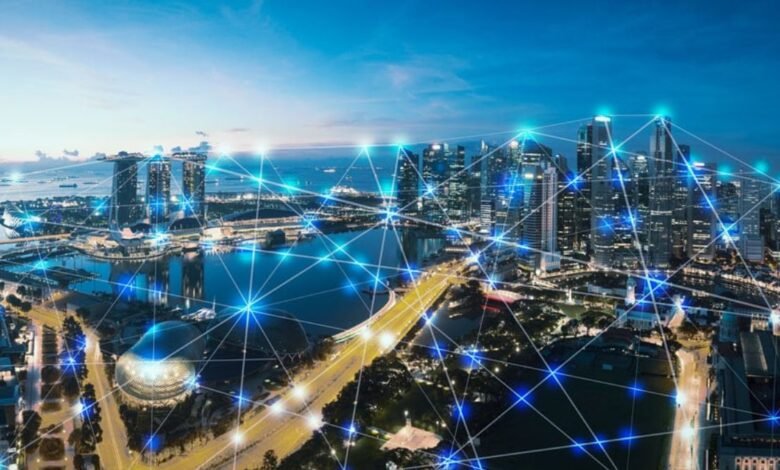Smart Cities: How Technology is Enhancing Urban Living

As urbanization continues to accelerate globally, the challenges of managing cities effectively are becoming more complex. With more than half of the world’s population now residing in urban areas, the need for innovative solutions to improve the quality of life in cities has never been greater. Enter the concept of “Smart Cities,” a transformative approach to urban living that leverages technology to enhance efficiency, sustainability, and overall well-being. This article delves into how smart cities are reshaping urban environments and improving the lives of their inhabitants.
Understanding Smart Cities: A New Paradigm in Urban Development
A smart city is more than just a buzzword; it represents a significant shift in how urban spaces are designed, managed, and experienced. At its core, a smart city uses digital technology to optimize city operations, promote sustainability, and enhance the quality of life for its residents. This integration of technology into urban infrastructure allows cities to become more responsive to the needs of their inhabitants.
The concept of smart cities is built on several pillars, including efficient energy use, advanced transportation systems, intelligent waste management, and enhanced public services. By harnessing data and technology, smart cities aim to create environments that are not only more efficient but also more inclusive and sustainable.
The Role of IoT and Big Data in Smart Cities
The Internet of Things (IoT) and big data are the backbone of smart cities. IoT refers to the network of connected devices and sensors that collect and exchange data in real time. In a smart city, these devices can range from traffic cameras and weather sensors to smart meters in homes and businesses. The data collected by these devices is then analyzed to inform decision-making and improve city services.
For instance, in a smart city, data from traffic sensors can be used to optimize traffic flow, reduce congestion, and minimize travel times. Similarly, smart meters can monitor energy consumption in real-time, allowing for more efficient energy distribution and reducing wastage. This interconnectedness enables cities to respond dynamically to changing conditions, leading to more efficient and sustainable urban living.
Enhancing Urban Mobility: Smarter Transportation Systems
One of the most visible impacts of technology on urban living is in the realm of transportation. Traditional urban transportation systems are often plagued by inefficiencies, congestion, and environmental concerns. Smart cities address these issues by implementing intelligent transportation systems (ITS) that leverage technology to improve mobility and reduce the environmental footprint of urban travel.
Smart transportation systems use data from various sources, including GPS, traffic cameras, and public transportation networks, to optimize traffic management and public transit services. For example, real-time traffic data can be used to adjust traffic signals dynamically, reducing congestion and improving traffic flow. Public transportation systems can also benefit from technology, with real-time updates on bus and train schedules, mobile payment options, and route optimization.
Moreover, smart cities are increasingly adopting electric and autonomous vehicles as part of their transportation infrastructure. Electric vehicles (EVs) contribute to reducing greenhouse gas emissions, while autonomous vehicles (AVs) promise to reduce accidents and improve traffic efficiency. These advancements are not just futuristic concepts but are already being implemented in cities around the world, signaling a shift towards more sustainable and efficient urban mobility.
Smart Infrastructure: Building Sustainable and Resilient Cities
Urban infrastructure is another critical area where technology is making a significant impact. Smart cities are designed with infrastructure that is not only more efficient but also more resilient to the challenges of the 21st century, such as climate change and population growth.
One example of smart infrastructure is the use of intelligent building systems. These systems incorporate advanced sensors and automation to optimize energy use, lighting, and heating in buildings. Smart buildings can adjust their energy consumption based on occupancy levels, weather conditions, and energy prices, leading to significant cost savings and reduced environmental impact.
Additionally, smart grids are revolutionizing the way cities manage energy. A smart grid is an electricity supply network that uses digital communications technology to detect and react to local changes in usage. This allows for more efficient energy distribution, reduces the likelihood of blackouts, and supports the integration of renewable energy sources like solar and wind power.
Water management is another area where smart infrastructure plays a crucial role. Smart cities use sensor networks to monitor water quality, detect leaks, and optimize water distribution. This not only ensures a reliable supply of clean water but also reduces water wastage and promotes conservation.
Public Safety and Health: Leveraging Technology for Better Urban Living
Ensuring the safety and well-being of citizens is a top priority for any city, and smart cities are using technology to enhance public safety and health in unprecedented ways. From crime prevention to healthcare delivery, smart cities are making urban environments safer and healthier places to live.
One of the key components of smart city public safety is the use of surveillance and monitoring technologies. For instance, smart cities deploy advanced CCTV systems equipped with facial recognition and artificial intelligence (AI) to monitor public spaces for suspicious activity. These systems can alert authorities to potential threats in real-time, allowing for faster and more effective responses.
In addition to crime prevention, smart cities are also enhancing emergency response capabilities. IoT-enabled devices can automatically alert emergency services in case of incidents such as fires, accidents, or natural disasters. For example, smart smoke detectors can notify fire departments the moment smoke is detected, even if no one is home.
Health services in smart cities are also benefiting from technological advancements. Telemedicine, remote monitoring, and AI-driven diagnostics are becoming increasingly common in smart cities, making healthcare more accessible and efficient. For instance, wearable devices can continuously monitor vital signs and alert healthcare providers if any anomalies are detected. This can be particularly beneficial for managing chronic conditions and providing timely interventions in emergencies.
Citizen Engagement: Fostering Inclusive and Participatory Urban Living
A truly smart city is not just about technology; it’s also about creating an environment where citizens are actively engaged in the governance and development of their city. Citizen engagement is a cornerstone of smart cities, ensuring that the benefits of technology are accessible to all and that urban development is aligned with the needs and aspirations of the community.
Smart cities use digital platforms and tools to facilitate communication between citizens and city officials. For example, mobile apps and online portals allow residents to report issues such as potholes, streetlight outages, or waste management problems directly to the relevant authorities. This not only speeds up the resolution of such issues but also empowers citizens to play an active role in maintaining their city.
Participatory planning is another aspect of citizen engagement in smart cities. Through digital platforms, citizens can contribute to urban planning processes by providing feedback on proposed developments, participating in virtual town hall meetings, and even co-creating solutions for local challenges. This inclusive approach ensures that urban development reflects the diverse needs of the population and fosters a sense of ownership and pride among residents.
The Future of Smart Cities: Opportunities and Challenges
As the concept of smart cities continues to evolve, the future holds both exciting opportunities and significant challenges. On one hand, the ongoing advancements in technology promise to make cities more efficient, sustainable, and livable. On the other hand, the implementation of smart city technologies raises important questions about privacy, equity, and governance.
One of the key opportunities for the future of smart cities lies in the continued integration of emerging technologies such as AI, 5G, and blockchain. These technologies have the potential to further enhance the capabilities of smart cities, enabling even more sophisticated data analysis, faster communication, and more secure transactions. For example, AI-driven analytics can provide deeper insights into urban trends, helping city planners make more informed decisions. Similarly, 5G networks can support the massive amounts of data generated by IoT devices, ensuring seamless connectivity in smart cities.
However, the widespread adoption of smart city technologies also brings challenges, particularly in the areas of privacy and data security. The vast amounts of data collected by smart city systems can be vulnerable to cyberattacks or misuse, raising concerns about the privacy of citizens. Ensuring that smart city technologies are implemented with robust security measures and transparent data governance practices will be critical to maintaining public trust.
Equity is another challenge that smart cities must address. While technology has the potential to improve the quality of life for all residents, there is a risk that the benefits of smart city developments may not be evenly distributed. To prevent the digital divide from widening, smart cities must prioritize inclusive development and ensure that all citizens have access to the benefits of technology.
Conclusion: The Path Forward for Smart Cities
Smart cities represent a transformative vision for urban living, where technology is harnessed to create more efficient, sustainable, and inclusive environments. From smarter transportation systems and resilient infrastructure to enhanced public safety and citizen engagement, the potential of smart cities to improve the quality of life is immense.
As cities around the world continue to explore and implement smart city initiatives, it is crucial to strike a balance between innovation and inclusivity. By addressing the challenges of privacy, equity, and governance, smart cities can pave the way for a future where urban living is not only more convenient but also more just and sustainable.
In conclusion, the journey towards smart cities is still in its early stages, but the direction is clear. As technology continues to advance, the possibilities for enhancing urban living are endless. With thoughtful planning and inclusive development, smart cities can truly become the blueprint for the cities of tomorrow, where technology serves the greater good and enhances the quality of life for all residents.



